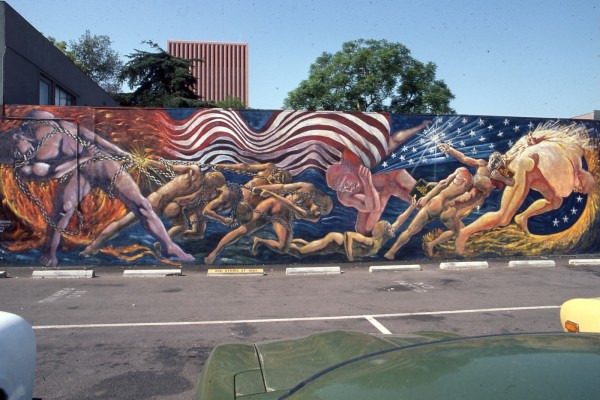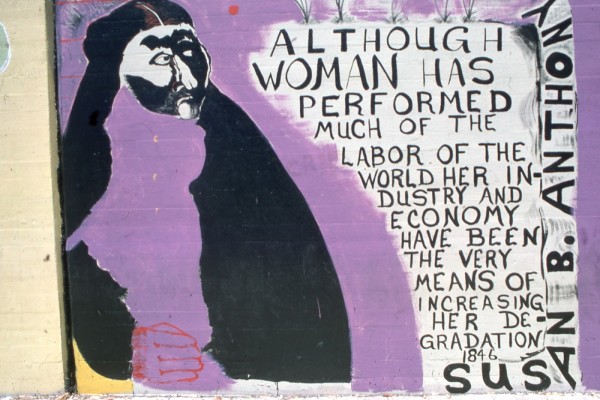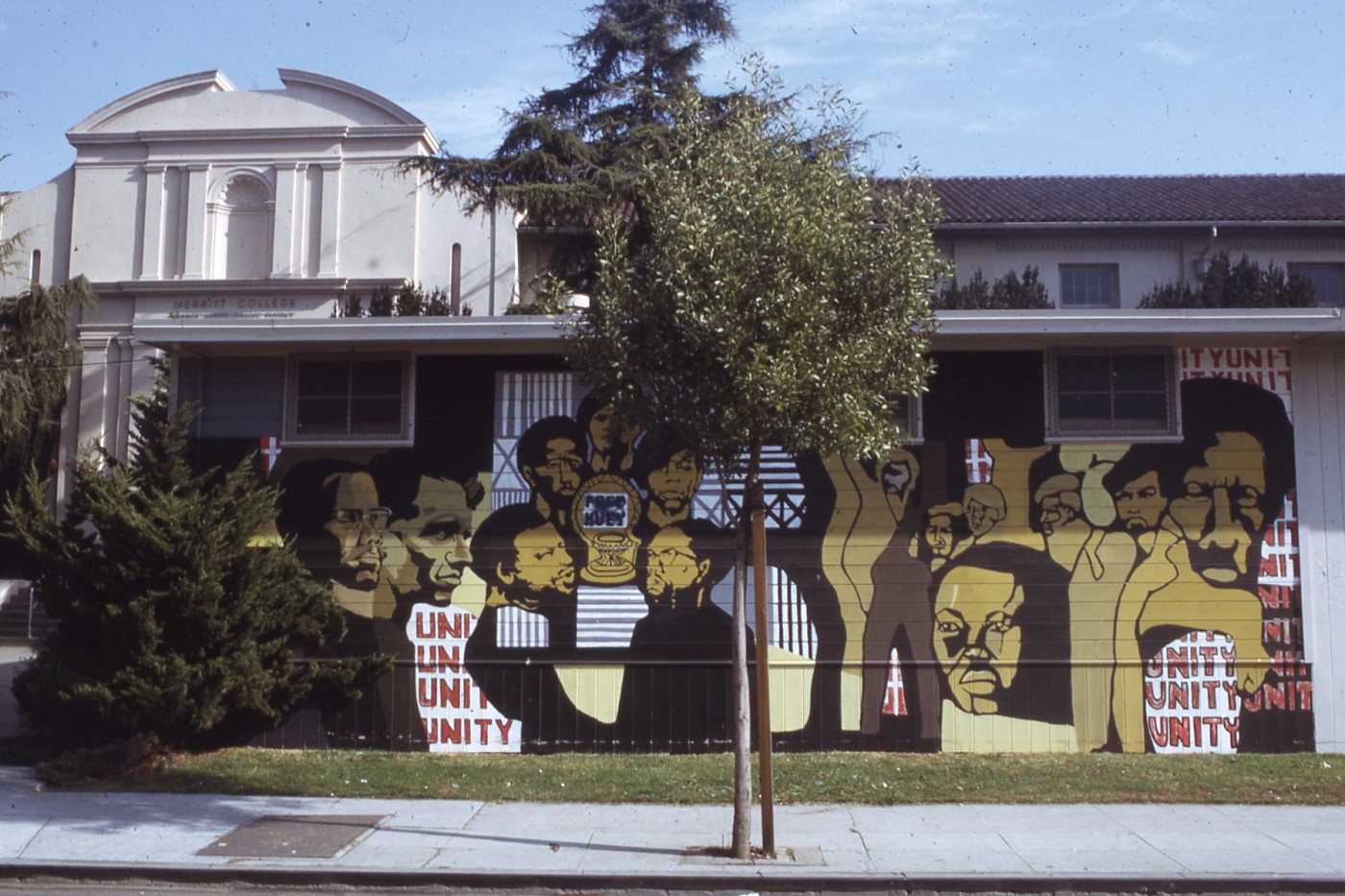Thank you to SPACES Archives spring semester 2025 intern Lili Alderson for preparing this blog post while she worked on digitizing Seymour Rosen's vast collection of documentation of murals throughout Los Angeles. Please get in touch if you'd like to see more of Seymour's mural images!
Though the Civil Rights Movement took place primarily from the mid-1950s to 1968, the ripples of the movement have continued to be felt across the United States. One of the places where the movement continued to have a great impact was Los Angeles. Those fighting for civil rights not only used their voices to protest the injustices against them, but they also used art to demonstrate their fight for rights. Murals, many depicting social justice themes, were on almost every street corner of the city. Photographer and cultural advocate Seymour Rosen documented hundreds of murals that he encountered during this transformative time.
The mural above (documented by Rosen) pays homage and highlights African Americans’ continued fight for their rights. This untitled mural, which was located in Oakland, California, highlights several prominent Black men from the 1960s. In the background of these men is the word “Unity.” This may serve as a reminder that the African American community is strongest together.
Another eye-catcher in this work is the words “free Huey,” and instead of showing who he is, the art depicts what looks to be a chair. “Huey” is a nod to Huey P. Newton, an African American revolutionary and political activist who founded the Black Panther Party. The chair is shown as a reference to one of his most well-known photos, conveying that while he may have been imprisoned for his fight for equal rights, he is still a prominent person in this fight. The overall background of this mural shows what appears to be bars, which could be a reference to the time spent in jail as a way to try to oppress these men.

"Ad Astra Per Aspera," José Luis González and Robert Arenivar, 1975 (non-extant). Photo: Seymour Rosen, n.d.
Alongside the Civil Rights Movement was the Chicano Movement. Similar to the Civil Rights Movement, the Chicano Movement sought to bring attention to systemic racism and discrimination. This time, however, the focus was on Mexican Americans who advocated for civil rights along with political rights and the revitalization and empowerment of their culture. This movement can be said to have started in 1965 during the Delano Grape strike, where farm workers, consisting of Filipinos and Mexicans, went on strike in hopes of gaining higher wages and better working conditions.
The strike took place in California, and the area soon became known for being a center for the Chicano Movement. One of the most interesting murals, captured by Rosen above, is titled “Ad Astra Per Aspera.” This mural, translated from Latin to English, means “Through Adversity to the Stars” and was created in 1975 by artists José Luis González and Roberto Arenivar, with the support of the student organization Movimiento Estudiantil de Chicanos de Aztlán (MEChA). It was located on the University of Southern California campus, specifically on the El Centro Chicano building. This mural reportedly raised eyebrows from students and backlash from administrators, as they felt that this was not the type of messaging they wanted to reflect the institution's image.
What is particularly interesting is one figure that appears to be bigger than the others and has a purplish hue. This is thought to be a representation of superstition. In Mexican culture, the color purple tends to represent pain, suffering, grief, and mourning. This human embodiment of superstition is pulling back students who are trying to fight their way to the other end, where knowledge is being held. The two books held by individuals say in Latin Per Aspera and Ad Astra, which together translate to “Through hardships to the stars,” the title of this mural. The overall message from this mural is that one must overcome challenges to be able to achieve great aspirations. There is also a torch that looks very similar to the one the Statue of Liberty holds, signifying freedom. Within this mural, we see what are presumably Hispanic people fighting for a better life through the power of knowledge.

Artist unknown. Photo: Seymour Rosen, Los Angeles, CA, n.d.
A third movement that was highlighted as murals on the walls of California buildings was second-wave feminism, which took place from the 1960s through the 1980s. The above mural shows a woman and a quote from suffragette leader Susan B. Anthony: “Although woman has performed much of the labor of the world, her industry and economy have been the very means of increasing her degradation.” This quote is from the book History of Woman Suffrage, volume one, edited by Anthony and other suffragette leaders. The artist of this mural, however, gives Anthony the credit along with the year 1846, which was the year in which the New York State constitutional convention was held, where six land-owning women demanded the “equal and civil and political rights” enjoyed by their male counterparts (for whites only, at this time). While their demands were denied, this was seen as a key moment within the first-wave feminist movement. The quote highlights the issue that women faced then and even now –that while women have impacted much of the labor and economy, their efforts have been used to bring them down. References in the book state that “Not being free, the results of her labor have gone to build up and sustain the very class that has perpetuated this injustice.” Turning our attention back to the mural, we can see that the mural consists of pinks and whites, both colors that have been connected to women's suffrage. By bringing attention to this issue in a public space, the artist highlights the fact that despite women’s contributions to society, that very society is pushing her down. It appears to be a call to action for women not to tolerate this, and the idea that society needs to treat women better.
While society has made leaps and bounds in the fight for justice for disadvantaged communities over the years, there is still much work to be done. Many of these murals may no longer exist, but Rosen’s documentation shows that groups like Black Lives Matter and the Chicano and feminist movements are not recent phenomena but ongoing struggles.
Sources:
- https://impa.usc.edu/asset-management/2A3BF1MYDC8Y1?FR_=1&W=1470&H=761
- https://www.jstor.org/stable/27245054?seq=17
- https://jlgoez.com/project/usc-mural/
- https://www.parks.ca.gov/pages/663/files/DiaTourHandout_20201211.pdf
- https://www.gutenberg.org/files/28020/28020-h/28020-h.htm
Primary Image: Artist unknown. Photo: Seymour Rosen, Los Angeles, 1972


Post your comment
Comments
No one has commented on this page yet.